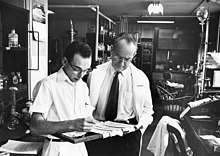Irvine Page
Irvine Heinly Page (January 7, 1901 – June 10, 1991) was born in Indianapolis, Indiana and was an American physiologist who played an important part in the field of hypertension for almost 60 years while working at the Cleveland Clinic as the first Chair of Research.[1][2][3]
Irvine Heinly Page | |
|---|---|
 Irvine Page (right) and lab tech in the 1960s. | |
| Born | January 7, 1901 |
| Died | June 10, 1991 (aged 90) |
His first contributions were published in the early 1930s and his most recent, "Hypertension Research: A Memoir : 1920–1960", in 1988. He is perhaps best known for the co-discovery of serotonin in 1948,[4] although his pre-eminence is a matter of record in four other areas: the renin–angiotensin system, the mosaic theory of hypertension,[5] treatment of hypertension and public and professional advocacy of the recognition of this condition and its effects in daily life. In earlier work he published on the neurochemistry of the brain.
Page received many honors for his work. He was on the cover of Time magazine in 1955.[6] He was president of the American Heart Association (1956–57); he received ten honorary degrees and a number of prestigious awards—the Ida B. Gould Memorial Award of the American Association for the Advancement of Science (1957); Albert Lasker Award (1958); Gairdner Foundation International Award (1963); Distinguished Award of the American Medical Association (1964); Oscar B. Hunter Award (1966); Golden Plate Award of the American Academy of Achievement (1966);[7] Passano Foundation Award (1967); and the Stouffer Prize (now the Novartis Award) for Hypertension Research in 1970. He was elected to the National Academy of Sciences in 1971 and published his memoirs in 1988.
The American Heart Association Irvine H. Page Young Investigator Research Award and the Irvine Page – Alva Bradley Lifetime Achievement Award are named in his honor.
A collection of his papers is held at the National Library of Medicine in Bethesda, Maryland.[8]
Personal life
Page was educated at Cornell University, with an undergraduate degree in chemistry (1921) and an M.D. degree in 1926.[9][10] He was married to Beatrice Allen, a dancer, poet, and author of the book, The Bracelet. His sister was Ruth Page, noted American ballet dancer. Page was also a gifted musician, a trait he passed on to his two sons, Christopher Page and Nicholas Page. Page lived in Cleveland, OH with his wife and children, summering in Hyannis Port on Cape Cod. His family home on the Cape is now owned and occupied by his granddaughter and great grandchildren.
Footnotes
- Dustan, HP (1990). "Irvine Page lecture. Legacies of Irvine H. Page". Journal of Hypertension Supplement. 8 (7): S29–34. PMID 2095393.
- Dustan HP Irvine Heinly Page. The National Academies Press Biographical Memoirs.
- Frohlich ED, Dustan HP, Bumpus FM Irvine H. Page: 1901-1991. The Celebration of a Leader Hypertension 1991;18:443–445.
- Rapport, MM; Green, AA; Page, IH (1948). "Serum vasoconstrictor (serotonin). IV. Isolation and characterization". J Biol Chem. 176 (3): 1243–1251. PMID 18100415.
- Page, IH (1967). "The mosaic theory of arterial hypertension--its interpretation". Perspectives in Biology and Medicine. 10 (3): 325–33. doi:10.1353/pbm.1967.0031. PMID 6034593.
- issue
- "Golden Plate Awardees of the American Academy of Achievement". www.achievement.org. American Academy of Achievement.
- "Irvine H. Page, M.D. Papers 1917–1989". National Library of Medicine.
- https://news.weill.cornell.edu/sites/default/files/publications/wcm_vol15_no3.pdf
- http://www.nasonline.org/publications/biographical-memoirs/memoir-pdfs/page-irvine.pdf
Bibliography
- Page, Irvine (1987). Hypertension Mechanisms. Orlando, Fla.: Grune & Stratton. ISBN 978-0-8089-1768-7.
- Page, Irvine (1988). Hypertension Research: A Memoir : 1920-1960. New York: Pergamon. ISBN 978-0-08-036079-9.
- Page, Irvine (1937). Chemistry of the brain. New York: C.C. Thomas. ASIN B-000-87D23-C.